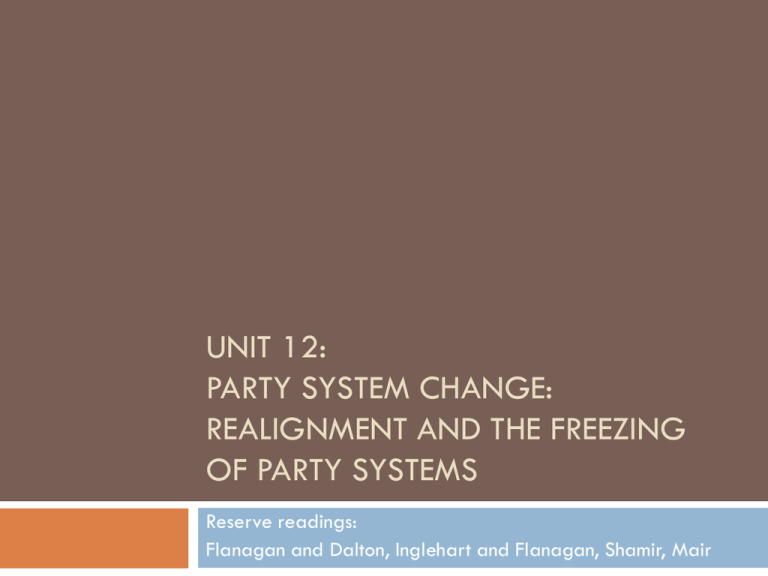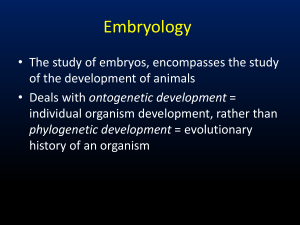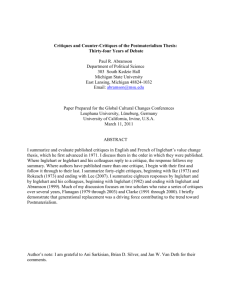Realignment
advertisement

UNIT 12: PARTY SYSTEM CHANGE: REALIGNMENT AND THE FREEZING OF PARTY SYSTEMS Reserve readings: Flanagan and Dalton, Inglehart and Flanagan, Shamir, Mair Guiding Questions What is realignment? How do we determine if realignment is occurring? What do we mean when we say that party systems are “frozen”? Are party systems “frozen”? What challenges do political parties face from realignment? Verzuiling and the Freezing of Party Systems Lipset and Rokkan 1967 Party systems are frozen in the aftermath of the extension of universal suffrage. How do party systems “freeze”? Rokkan 1977 Verzuiling = Pillarization Vertical networks used by societal groups and political parties to promote group identity. Isolate supporters into groups with others who share outlook or identity. Increases social distance when physical distance no longer ensures cultural or ideological distinctiveness. As other entities become critical for the dissemination of political information, pillarization declines (ontzuiling). Why do we care? Can create opportunities for extreme parties Can indicate a lack of connection to the political system. Realignment Flanagan and Dalton 1984; 1990 Changes in the salience of certain cleavages changes partisan alignments Weaker party attachment creates volatility How do cleavages weaken? Generational change Younger generations do not share the same intensity on a given issue as older generations. Realignment is cyclical. Differentiation of party appeals at first, then convergence over time as salience of cleavage wanes. Expects volatility to increase prior to realignment, level off after and then slowly increase. What types of events can restructure partisan alignments? Critical junctures. End of the Cold War: Critical Juncture? Ware 1996 Speculates about what a “critical juncture” might look like Suggests the end of the Cold War has shaped political competition in some systems. Cold War “anchored” several advanced democratic parties systems (e.g. Italy) Notes: 1) Changes in vote share of governing parties. 2) Rise of new parties. But also suggests that these changes may be 1) Temporary for governing parties; retrenchment at subsequent elections 2) Effective in only a small number of cases 3) Temporary for new parties; difficult to gain a foothold within the system Globalization: Critical Juncture? Kriesi 2008 Speculates that globalization has fostered a new cleavage. Divides those that benefit from globalization (integration) from those who do not (demarcation) Integration/demarcation cleavage is a result of the “weakening” of the state’s ability to control changes in economics, politics, and culture. Result: Political parties stoke anxieties amongst those who “lose” from globalization. Manifests itself in the rise of populist right parties. Kriesi 2009 Further research suggests that this new cleavage is not as pervasive as previously thought. Has not eclipsed other traditional cleavages in most countries. Postmaterialism: Critical Juncture? Inglehart 1977, 1987 Priorities in advanced democracies shifting from a materialist towards a postmaterialist phase. Advanced democracies exhibit concerns for socio-tropic concerns rather than ownership of the means of production. Voters place priority on needs that are in short supply. Younger groups have different needs than older cohorts. Relative affluence in postwar era shifts outlook. Voters retain values structure throughout their lives Although changes take time to manifest themselves in the party system. Postmaterialism and the Left Inglehart 1987 Posits that postmaterialism places a particular strain on parties of the left. Absence of total war facilitates shift to postmaterialism. Policies of state intervention and protection of the welfare state pass the “point of diminishing returns.” As societies become “more equal” the coalition in favor of further redistribution declines. Left is a victim of their own “success” Result: Splits on the left: Sense of community and quality of life issues trump issues of class for middle and upper class voters (shift to the Greens) Counter-response on the right Restoring “order” can prompt a shift from working c lass voters on the left to parties of the right (shift to Conservatives, Christian Democrats or far right) Evaluating Postmaterialism Flanagan 1987 Libertarianism and postmaterialism are similar, but materialism should be more tightly defined. Focus on voters privileging a stable economy, lowering prices, etc. Inglehart ignores the ‘new right” Authoritarianism has also resulted from postmaterialism Intolerance towards outsiders, strong support for law and order, patriotism, etc. These voters are shifting from the old left to the new right. Are Party Systems Frozen? What does the presence of new cleavages suggest about Lipset and Rokkan’s “freezing hypothesis”? Theories of realignment would argue that the system has changed But the jury is out about whether or not this negates the freezing hypothesis. No consensus. Questions include: 1) How would we test the “freezing hypothesis”? 2) What constitutes the “freezing” of party systems? 3) What constitutes the “thawing” of party systems? Are Party Systems “Frozen”? Shamir 1984 What does it mean to say that party systems are “frozen”? Possible explanations: Definition of freezing 1) stability in party support at the ballot box 2) persistence of a given set of parties and party organizations 3) persistence in mass loyalties to parties. “The party system is stable if it tends or is able to recover its original position or steady motion when disturbed by exterior forces or interventions” Freezing does not mean no change at all. But rather- “stability means then that the party system is not affected— not in any essential way and only temporarily—by outside factors” Are Party Systems “Frozen”? Shamir 1984 Examines elections in 19 systems both within and outside Europe. Looks at several systemic variables including: 1) party system instability (volatility) 2) party system fragmentation 3) ideological polarization Includes systemic variables and a variable to account for randomness. Includes Australia, Canada, Israel, Japan, New Zealand, and the US Time frame includes all elections where there is an “identifiable” party system. If systems are “frozen” stability at time t+1 should be dependent upon stability at time t. If systems are “thawing” stability at time t+1 may be dependent upon random factors from previous elections. Finds that most party systems are not “thawing” Argues that they were never frozen to begin with. Are Party Systems “Frozen”? Mair 2001 Debate over whether party system change is a function of 1) Cleavage change (are cleavage patterns persisting?) 2) Party instability (are traditional parties remaining?) What does it mean to suggest that party systems are “frozen”? 1) Cleavage system is frozen into place. Same social cleavages coupled with the same parties. 2) Freezing of political parties competing May or may not be associated with the previous cleavage structure. 3) Freezing of party systems Both speak to different concepts of freezing (and both could be correct) Patterns of inter-party competition are frozen. The freezing hypothesis is only realistic when applied to the third category. Are Party Systems “Frozen”? Mair 2001 If patterns of competition within a system are “stable” the system is frozen. Voters are choosing not only between parties but also between governments. As long as the patterns of competition remain the same the identities of the parties can change and the system can remain stable. Stability appears to be the norm. Although some party systems are more “predictable” than others. Predictability is becoming rarer. Political institutions can facilitate freezing. But institutional reform could lead to further “thawing” Conclusions FREEZING Is the left-right cleavage still the most relevant to understanding modern politics? Yes. Are the same parties fighting today that were fifty years ago? In most cases, yes. Are patterns of government changing frequently? No. But some cases fluctuate more than others. THAWING Have cleavage structures changed? Consensus appears to be yes. Are there new parties on the scene? Certainly. Are patterns of governance changing? Perhaps But some cases exhibit more predictability than others. Next Unit Theme: Dealignment Readings: Dalton and Wattenberg CH 2-4 Reserves: Mair et al. pgs. 145-178










